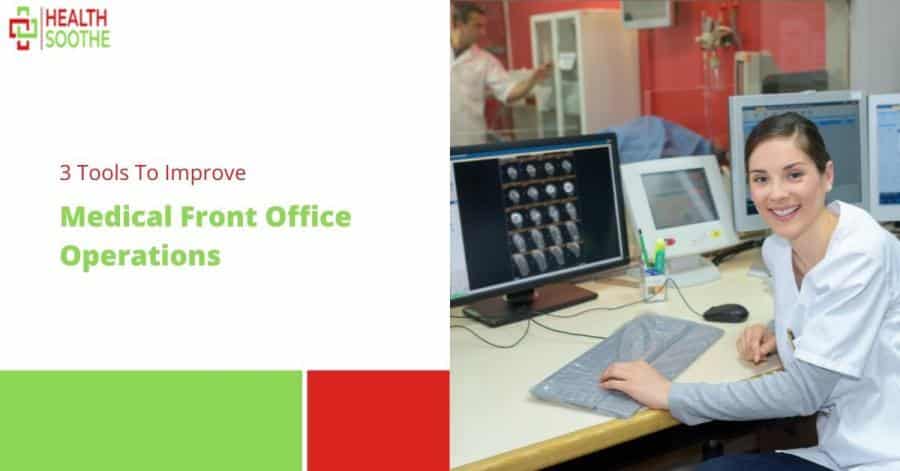When we think of upscaling any area of a business, be it in finance, production, or even health, the front desk or front office is always one of the last areas to be considered. But did you know that the medical front office plays a vital role in workflow efficiency and work distribution efficiency? Apart from being any client or patient’s first contact, the front office is in charge of the daily schedule and dispensation of work. Once it isn’t well equipped to perform the necessary tasks of the day, every other area can be drastically affected.
A clinic or hospital’s front office is no different, and considering the large volume of patients treated and the high volume of patient information required, processed, and stored daily, an efficient medical front office would improve the overall service and output of the hospital in general. To this end, technological advances in various areas including front desk operations have created and made available certain tools that can improve by manyfold their activities. Here are some of those tools and what they can do.
1. Outsourced Services
One of the core duties of a front office is to serve as the bridge between the patients and the doctors, taking down vital information and patient details, scheduling appointments, requesting test results, and so on. This process in itself is quite taxing and time-consuming. Additionally, it can be quite damaging to the facility if not done appropriately.
To ensure proper and continued communication, a medical front office can make use of a virtual medical receptionist. This takes administrative tasks off the load of doctors. Find those who are highly skilled and HIPAA compliant. A virtual medical receptionist can help with:
- Appointment schedules with set preferences and parameters
- Patient data storage
- Collation of patient lab and test results
- Processing requests for tests and refills
- Provision of forms to be filled in and guidance on how to do so
With a virtual medical receptionist, doctors would not be overburdened with work and can dedicate time and resources to other areas.
2. Automated Appointment Reminders
One of the many issues that health care facilities face is having unfilled consultation slots due to the absence of a patient. The usual process of manual appointment reminder calls is time-consuming.
To curb and tackle this issue, a vital tool any medical front office can incorporate would be the automated appointment reminder system. This system automatically confirms patient appointments, sends reminders, and also keeps tabs on appointment confirmation statuses. All of these details are transferred and shared with the central management system to keep all involved parties updated on the necessary details.
Also, the automated appointment reminder can be done via text, email, and phone calls, and patients can choose their most preferred means of being reached. With this, there’s a higher response rate, and all staff are aware of the developments, schedules, and other details at all times.
3. Medical Billing And Payment Software
Another great challenge of medical front office staff is the recording of bills and payments. With many tasks and patients to attend to, often bill payment records are neglected. This could lead to issues and complaints from patients who need speedy assistance in the processing of their documents and records.
One way to ensure proper recording of bills, payments, and other financial aspects would be through the use of medical billing software. This software not only keeps all records of settled and unsettled bills but also provides details about when payments are made, mode of payment, and receipts.
Billing and payment software will automatically post the necessary payments to the patient’s account and offer contact-less means of payment like web links for online payments. While others, like an electronic statement service, will prepare and send an online statement of payment to the patient. This way, staff members don’t have to print statements, use extra resources to post them to patients, and manually enter details of payment into the system.
To aid you in choosing software, you can find ones that offer free trials. Seeing how the software actually works will help you decide with finality if it suits your needs.
Depending on the need of the medical center, there’s a variety of medical billing and payment software available to adequately cater to the needs of the patient while reducing the workload and stress of the members of staff.
Conclusion
Today, technological advancement has helped increase efficiency in a lot of areas, including medical services. With the right tools mentioned in this article, medical front offices will no longer be unduly swamped with duties, and patients can receive seamless service without stress and complaints.

Isreal olabanji a dental assistant and public health professionals and has years of experience in assisting the dentist with all sorts of dental issues.
We regularly post timely and trustworthy medical information and news on Fitness, Dental care, Recipes, Child health, obstetrics, and more.
The content is intended to augment, not replace, information provided by your clinician. It is not intended nor implied to be a substitute for professional medical advice. Reading this information does not create or replace a doctor-patient relationship or consultation. If required, please contact your doctor or other health care provider to assist you to interpret any of this information, or in applying the information to your individual needs.


